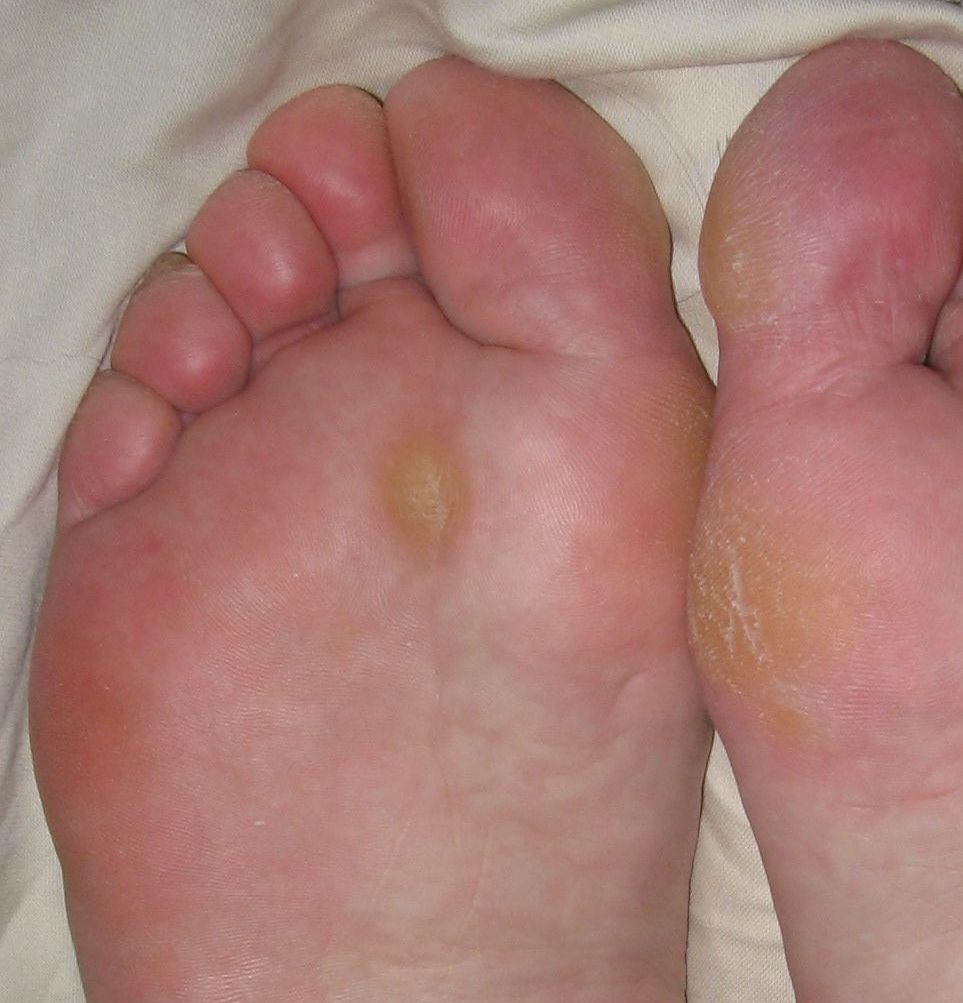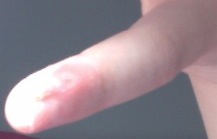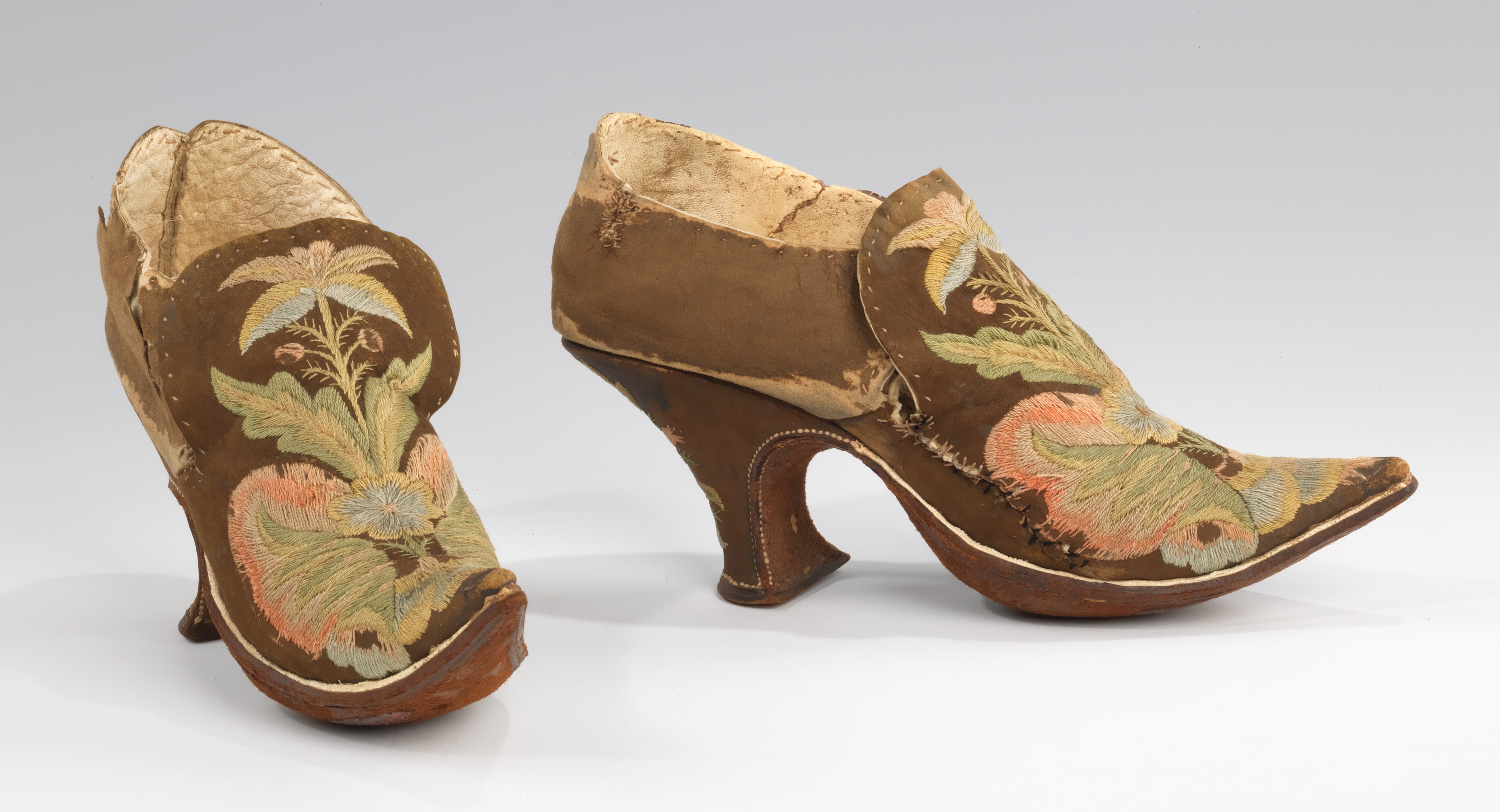|
Callus
A callus (: calluses) is an area of thickened and sometimes hardened skin that forms as a response to repeated friction, pressure, or other irritation. Since repeated contact is required, calluses are most often found on the feet and hands, but they may occur anywhere on the skin. Some degree of callus, such as on the bottom of the foot, is normal. Calluses are generally not harmful and help prevent blisters, as well as offering protection. However, excessive formation may sometimes lead to other problems, such as a skin ulceration or infection, or cause the affected person to try to offload the affected painful area, which can place excessive stress on the asymptomatic side. Rubbing that is too frequent or forceful will cause blisters, as opposed to calluses, to form. Cause Normally, a callus will form on any part of the skin exposed to excess friction over a long period of time. Activities that are known for causing calluses include construction work and craftwork, the ... [...More Info...] [...Related Items...] OR: [Wikipedia] [Google] [Baidu] [Amazon] |
Corn (pathology)
A corn or clavus (plural ''clavi'' or ''clavuses'') is an often painful, cone-shaped, inwardly directed callus of dead skin that forms at a pressure point near a bone, or on a weight-bearing part of the body. When on the feet, corns can be so painful as to interfere with walking. The visible portion of the corn tends to be more or less round, but corns are defined by having a hard tapering root that is directed inward, and pressure on the corn pushes this root deeper into the flesh (thus the Latin term ''clavus'' meaning "nail"). Pressure corns usually occur on thin or glabrous (hairless and smooth) skin surfaces, especially on the dorsal surface of toes or fingers, but corns triggered by an acute injury (such as a thorn) may occur on the thicker skin of the palms (palmar corns) or bottom of the feet (plantar corns). Pressure corns form when chronic pressure on the skin against an underlying bone traces a usually elliptical path during the rubbing motion. The corn forms at t ... [...More Info...] [...Related Items...] OR: [Wikipedia] [Google] [Baidu] [Amazon] |
Blister
A blister is a small pocket of body fluid (lymph, serum, plasma, blood, or pus) within the upper layers of the skin, usually caused by forceful rubbing (friction), burning, freezing, chemical exposure or infection. Most blisters are filled with a clear fluid, either serum or plasma. However, blisters can be filled with blood (known as "blood blisters") or with pus (for instance, if they become infected). Smaller blisters are called ''blebs''. The word "blister" entered English in the 14th century. It came from the Middle Dutch and was a modification of the Old French , which meant a leprous nodule—a rise in the skin due to leprosy. In dermatology, the words cutaneous condition#Vesicle, ''vesicle'' and ''bulla'' refer to blisters of smaller or greater size, respectively. Some sources recommend not to pop a blister. If popped, bacteria can enter. Excess skin should not necessarily be removed as the top layer protects the soft tissue underneath. However, some sources a ... [...More Info...] [...Related Items...] OR: [Wikipedia] [Google] [Baidu] [Amazon] |
Salicylic Acid
Salicylic acid is an organic compound with the formula HOC6H4COOH. A colorless (or white), bitter-tasting solid, it is a precursor to and a active metabolite, metabolite of acetylsalicylic acid (aspirin). It is a plant hormone, and has been listed by the EPA Toxic Substances Control Act (TSCA) Chemical Substance Inventory as an experimental teratogen. The name is from Latin for willow tree, from which it was initially identified and derived. It is an ingredient in some anti-acne products. Salts and esters of salicylic acid are known as salicylates. Uses Medicine Salicylic acid as a medication is commonly used to remove the outermost layer of the skin. As such, it is used to treat warts, psoriasis, acne vulgaris, ringworm, dandruff, and ichthyosis. Similar to other hydroxy acids, salicylic acid is an ingredient in many skincare products for the treatment of seborrhoeic dermatitis, acne, psoriasis, calluses, Corn (medicine), corns, keratosis pilaris, acanthosis nigricans, ... [...More Info...] [...Related Items...] OR: [Wikipedia] [Google] [Baidu] [Amazon] |
Keratolytic
Keratolytic () therapy is a type of medical treatment to remove warts, calluses and other lesions in which the epidermis produces excess skin. In this therapy, acidic topical medicines, such as Whitfield's ointment or Jessner's solution, are applied to the lesion in order to thin the skin on and around it. This therapy causes the outer layer of the skin to loosen and shed. Keratolytics can also be used to soften keratin, a major component of the skin. This serves to improve the skin's moisture binding capacity, which is beneficial in the treatment of dry skin. Such agents (keratolytics) include alkalis (by swelling and hydrolysis of skin), salicylic acid, urea, lactic acid, allantoin, glycolic acid, and trichloroacetic acid. While cytostatic agents such as zinc pyrithione are first line, keratolytics (salicylic acid and sulfur) can also be used in the treatment of dandruff and seborrheic dermatitis. Sulfur and salicylic acid can also be used to effectively treat acne an ... [...More Info...] [...Related Items...] OR: [Wikipedia] [Google] [Baidu] [Amazon] |
High Heels
High-heeled shoes, also known as high heels (colloquially shortened to heels), are a type of shoe with an upward-angled sole. The heel in such shoes is raised above the ball of the foot. High heels cause the legs to appear longer, make the wearer appear taller, and accentuate the calf muscle. There are many types of high heels in varying styles, heights, and materials. High heels have been used in various ways to convey nationality, professional affiliation, gender, and social status. High heels have been an important statement piece of fashion for centuries in the West. High heels spread from equestrian origins with the 10th century Persian galesh to wider fashion use. In early 17th-century Europe, high heels were a sign of masculinity and high social status. Towards the end of the century, the trend began to spread to women's fashion. By the 18th century, high-heeled shoes had split along gender lines. By this time, heels for men were chunky squares attached to riding boo ... [...More Info...] [...Related Items...] OR: [Wikipedia] [Google] [Baidu] [Amazon] |
Corns
Corn most often refers to maize, the yellow, large-grained crop native to the Americas. It can also refer to the main cereal crop of a country or region: * Wheat, barley and oats in England and Wales * Oats in Scotland and Ireland Corn may also refer to: Places * Corn, Lot, France * Corn, Oklahoma, United States People * Corn (surname), and persons with the name * Corn Griffin (1911–1973), American heavyweight boxer Other uses * Corn (color) * ''Corn'' (film), a 2004 movie * Corn (pathology), an ingrowing callus often on the foot * Corn, a type of snow Snow consists of individual ice crystals that grow while suspended in the atmosphere—usually within clouds—and then fall, accumulating on the ground where they undergo further changes. It consists of frozen crystalline water througho ... *'' Dracaena fragrans'' (cornstalk dracaena or happy plant), a flowering African shrub commonly kept as a house plant See also * Corne (other) * Corny (disambigua ... [...More Info...] [...Related Items...] OR: [Wikipedia] [Google] [Baidu] [Amazon] |
Induration
A skin condition, also known as cutaneous condition, is any medical condition that affects the integumentary system—the organ system that encloses the body and includes skin, nails, and related muscle and glands. The major function of this system is as a barrier against the external environment. Conditions of the human integumentary system constitute a broad spectrum of diseases, also known as dermatoses, as well as many nonpathologic states (like, in certain circumstances, melanonychia and racquet nails). While only a small number of skin diseases account for most visits to the physician, thousands of skin conditions have been described. Classification of these conditions often presents many nosological challenges, since underlying causes and pathogenetics are often not known. Therefore, most current textbooks present a classification based on location (for example, conditions of the mucous membrane), morphology ( chronic blistering conditions), cause ( skin conditions res ... [...More Info...] [...Related Items...] OR: [Wikipedia] [Google] [Baidu] [Amazon] |
Medscape
Medscape is a website providing access to medical information for clinicians and medical scientists; the organization also provides continuing education for physicians and other health professionals. It references medical journal articles, Continuing Medical Education (CME), a version of the National Library of Medicine's MEDLINE database, medical news, and drug information (Medscape Drug Reference, or MDR). At one time Medscape published seven electronic peer reviewed journals. History Medscape launched May 22, 1995, by SCP Communications, Inc. under the direction of its CEO Peter Frishauf. The first editor of Medscape was a P.A. named Stephen Smith. In 1999, George D. Lundberg became the editor-in-chief of Medscape. For seventeen years before joining Medscape he served as editor of the ''Journal of the American Medical Association''. In September 1999, Medscape, Inc. went public and began trading on NASDAQ under the symbol MSCP. In 2000, Medscape merged with MedicaLogic, In ... [...More Info...] [...Related Items...] OR: [Wikipedia] [Google] [Baidu] [Amazon] |
Cleveland Clinic
Cleveland Clinic is an American Nonprofit organization, nonprofit Academic health science center, academic Medical centers in the United States, medical center based in Cleveland, Ohio. Owned and operated by the Cleveland Clinic Foundation, an Ohio nonprofit corporation, Cleveland Clinic was founded in 1921 by a group of faculty and alumni from the Case Western Reserve University School of Medicine. The Clinic runs a main campus in Cleveland, as well as 15 affiliated hospitals, 20 family health centers in Northeast Ohio, 5 affiliated hospitals in Florida, and cancer center in Nevada. International operations include the Cleveland Clinic Abu Dhabi hospital in the United Arab Emirates and Cleveland Clinic Canada, which has two executive health and sports medicine clinics in Toronto."Facts & Figures" Cleveland Clini ... [...More Info...] [...Related Items...] OR: [Wikipedia] [Google] [Baidu] [Amazon] |
Plantar
Standard anatomical terms of location are used to describe unambiguously the anatomy of humans and other animals. The terms, typically derived from Latin or Greek roots, describe something in its standard anatomical position. This position provides a definition of what is at the front ("anterior"), behind ("posterior") and so on. As part of defining and describing terms, the body is described through the use of anatomical planes and axes. The meaning of terms that are used can change depending on whether a vertebrate is a biped or a quadruped, due to the difference in the neuraxis, or if an invertebrate is a non-bilaterian. A non-bilaterian has no anterior or posterior surface for example but can still have a descriptor used such as proximal or distal in relation to a body part that is nearest to, or furthest from its middle. International organisations have determined vocabularies that are often used as standards for subdisciplines of anatomy. For example, '' Terminologi ... [...More Info...] [...Related Items...] OR: [Wikipedia] [Google] [Baidu] [Amazon] |





